Refurbishing a block paved driveway
This page is one in a series which documents the refurbishment of an existing block paved driveway. Although the page can be read as a standalone article, it will probably make more sense if read in conjunction with the associated pages listed below.
Part 2: Oil Stain Removal

The Problem
One area on the driveway has been subjected to a slow drip, drip, drip of engine oil from one of the family cars. Luckily, the stain hasn't been around for more than a couple of months and the oil that has dripped is relatively clean, not the thick black gunk that is often found escaping from a diesel-engined vehicle.
When the pavement surface is damp, the oil stain, which is actually more of a darkening or discolouration rather than a stain, is barely noticeable, but when the surface is dry, it is immediately apparent. It would make no sense aesthetically to leave the oil discolouration in place given the amount of effort being made elsewhere on the driveway, but there is also a sound structural reason to fix the problem. Most sealants will not bond properly to a surface that is contaminated by oil or oil-based products. In fact, some sealants will positively recoil from any surface that is affected by oil, diesel, petrol, transmission fluid, brake fluid or any other oil-based product.
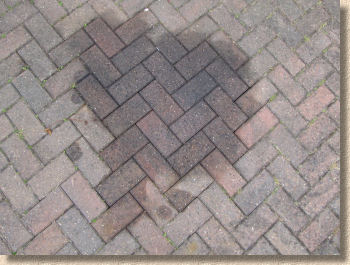
The oil stain A two-stage plan of attack was prepared. Firstly, an attempt to clean the oil would be undertaken, but if this was not successful, or not as successful as we would like it to be, the back-up plan would involve removing and replacing affected blocks.
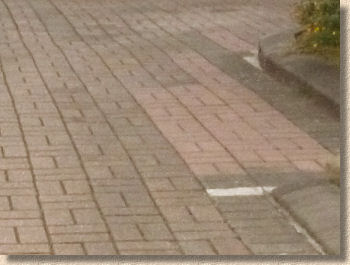
The affected area measures approximately 1m² which would require up to 50 replacement blocks. The problem with replacing such a relatively large cluster of blocks is that there is virtually zero chance of the replacements blending in seamlessly with the existing, and there is a genuine risk that the ' sore thumb syndrome ' of any replacement blocks would be more of a visual disturbance than the oil discolouration they were replacing. So, fingers crossed that the oil stain removers would work!
There are a number of 'home made' remedies for oil stains, and a few of the more credible suggestions are outlined on the Dealing With Stains page, but for this project, the remit is to refurbish the driveway using off-the-sheff products wherever possible, and so it was decided to try one or two of the better proprietary Oil Removing potions that are reasonably easy to obtain.
First attempt:
A fellow contractor had recommended the product "Oil Patch Remover" as supplied by a certain housewares distribution company.
A one litre bottle of this jollop was acquired for under a tenner, which may seem pricey, but if it renovates just half a square metre of blocks, it will have more than paid for itself.
The "Oil Patch Remover" was applied to the surface in full accordance with the manufacturer's recommendations, which basically involved applying the transparent liquid to the stained area, scrubbing with a plastic-bristled brush, leaving for 10-15 minutes (but not allowing it to dry) and then rinsing off.
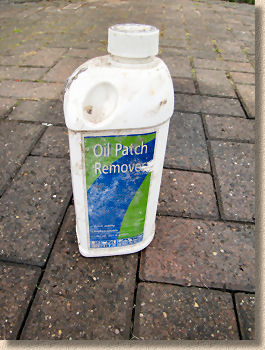
This first clean did remove the most obvious of the oil residue but a significant stain remained and so after 30 minutes or so, a second treatment was undertaken, and again, some of the oil was lifted but the end result was that a noticeable oil stain remained. Had this been a basic cleaning exercise, the result may have been satisfactory as the result was reasonable and the stain not as immediately noticeable.
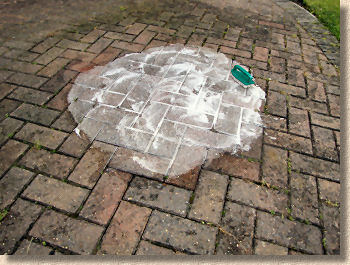
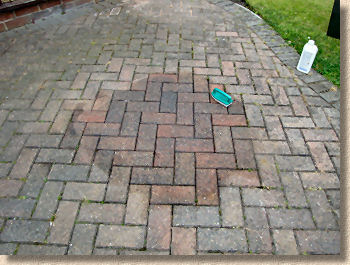
However, as this was to be a thorough clean and it was critical that the oil was fully removed to ensure proper adhesion of the eventual sealant, advice was sought from the sealant manufacturer and they recommended their own Resiblock OR product. However, this could not be delivered to site for 48 hours and the surface cleaning process was imminent, and so it was decided to allow the driveway cleaning to proceed and to return to the residual oil stain at a later date.

Second attempt:
This was carried out some days after the driveway had been surface cleaned .
It was felt that the cleaning process had not made any significant difference to the residual oil staining. The dirt component of the stain had largely been removed by the previous treatment described above , but the use of a high-pressure wash had not noticeably reduced the visual impact of the remaining oil which had penetrated the concrete blocks.
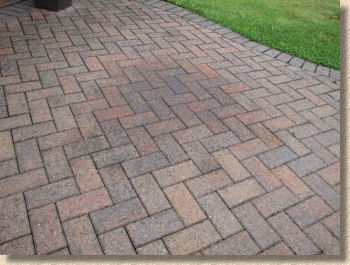
Resiblock OR is supplied in a 5 litre steel canister and appears as a transparent liquid. The canister needs to be thoroughly shaken to mix the contents before applying to the contaminated surface. The safety data sheet recommends wearing eye protection and suitable gloves when working with the product, so this was done.
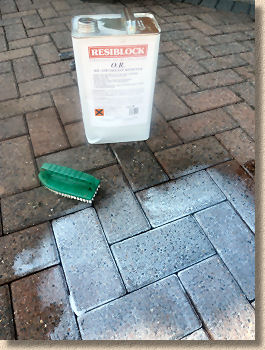
The Resiblock OR was poured onto the stained area and then spread using a plastic-bristled brush, before being given a good scrubbing with the same brush. This scrubbing action generates many minor splashes and sprays and so it became apparent why the hand and eye protection was recommended. The OR develops a white, frothy appearance when agitated on the surface of the paving.
Once scrubbed in, the Resiblock OR was left for roughly 15 minutes before being rinsed away using a pressure washer. The application guide stresses that it is vital that the Resiblock OR is not allowed to dry on the surface, so on warmer days, a shorter period may be necessary.
Rinsing off is very simple. The lather washes off with ease and the pressure of the water ensures that and remaining froth is flushed out from the joints and other recesses. After one treatment, the surface was allowed to dry off so that the results could be assessed.
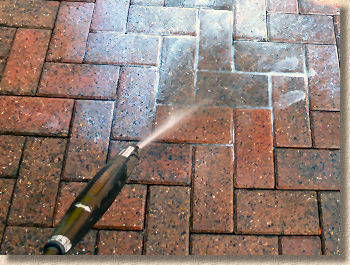
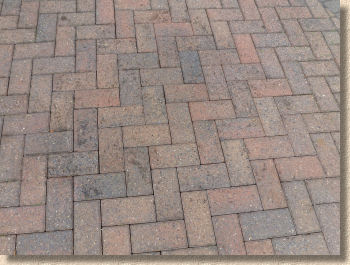
Even after just a single treatment, the difference was dramatic. There was no visible trace of any oil residue. The photograph shows the last vestiges of dampness remaining but it should be apparent that the oil discolouration is completely gone and that the blocks are indistinguishable from their unaffected neighbours. Impressive!
As a 'belt and braces' operation, the area was given one final treatment with the Resiblock OR two days later. This was not strictly necessary and there was no noticeable improvement on the initial results. However, some residual oil may have remained deep within the concrete blocks and so the follow-up treatment was undertaken more for reassurance than for necessity.
Two days after the second treatment with Resiblock OR , when the surface had completely dried, it was impossible to identify which blocks had originally been stained and which had not.
Video:

